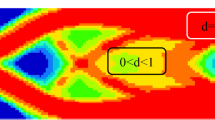Abstract
Metal additive manufacturing is a major field of study and innovation. In almost every industry, a lot of effort goes into modelizing and optimizing designs in order to minimize global mass. In this context, despite all efforts, metal additive manufacturing, especially SLM, still produces parts generally considered as raw parts with some surfaces still needing to be machined in order to obtain the required geometrical quality. Despite sometimes, great complexity and cost, the machining stage is never taken into account in the design process, especially during the topological optimization approach. This paper proposes a new design for the additive manufacturing method in order to optimize the design stage and takes into account topological optimization machining as well as geometrical and mechanical constraints. The machining constraints are initially integrated as forces and functional surfaces, but also as the result of a topological optimization loop, in order to find the best possible mounting solution for machining. It is shown on a typical aeronautic part that machining forces may be indeed the greatest forces during the part’s lifetime. Using two different topological optimization software, i.e. Inspire and Abaqus Tosca, the paper illustrates that it is possible to take into account most of the machining constraints to only slightly modify the initial design and thus simplify the machining stage and reduce cost and possible failure during machining.












Similar content being viewed by others
References
Kruth J-P (1991) Material increase manufacturing by rapid prototyping techniques. CIRP Ann 40:603–614
Levy GN, Schindel R, Kruth JP (2003) Rapid manufacturing and rapid tooling with layer manufacturing (LM) technologies: state of the art and future perspectives. CIRP Ann-Manuf Techn 52:589–609
Kruth JP, Mercelis P, van Vaerenbergh J, Froyen L, Rombouts M (2005) Binding mechanisms in selective laser sintering and selective laser melting. Rapid Prototyp J 11 1:26–36
Pessard E, Mognol P, Hascoët JY, Gerometta C (2008) Complex cast parts with rapid tooling: rapid manufacturing point of view. Int J Adv Manuf Technol 39:898–904
Kranz J, Herzog D, Emmelmann C (2015) Design guidelines for laser additive manufacturing of lightweight structures in TiAl6V4. J Laser Appl 27:S14001
Horn TJ, Harryson OLA (2012) Overview of current additive manufacturing technologies and selected applications. Sci Prog 95(3):255–282
Guo N, Leu MC (2013) Additive manufacturing: technology, applications and research needs. Front Mech Eng 8:215–243
Bendsøe MP (1989) Optimal shape design as a material distribution problem. Struct Optim 1:193–202
Zhou M, Rozvany GIN (1991) The COC algorithm, Part II: Topological, geometrical and generalized shape optimization. Comput Methods Appl Mech Eng 89:309–336
Stolpe M, Svanberg K (2001) An alternative interpolation scheme for minimum compliance topology optimization. Struct Multidiscip Optim 22:116–124
Boothroyd G, Alting G (1992) Design for assembly and disassembly. CIRP Ann 41:625–636
Kerbrat O, Mognol P, Hascoët JY (2011) A new DFM approach to combine machining and additive manufacturing. Comput Ind 62:684–692
Rosen DW (2007) Design for additive manufacturing: a method to explore unexplored regions of the design space, 18th Annual SFF symposium
Gibson I, Rosen DW, Stucker B (2010) Design for additive manufacturing. in: additive manufacturing technologies. Springer US, pp 283–316. https://doi.org/10.1007/978-1-4419-1120-9_11
Kumke M, Watschke H, Vietor T (2016) A new methodological framework for design for additive manufacturing. Virtual Phys Prototyp 11:3–19
Ponche R, Hascoet JY, Kerbrat O, Mognol P (2012) A new global approach to design for additive manufacturing. Virtual Phys Prototype 7:93–105
Vayre B, Vignat F, Villeneuve F (2012) Designing for additive manufacturing. Procedia CIRP 3:632–637
Reiher T, Lindemann C, Jahnke U, Deppe G, Koch R (2017) Holistic approach for industrializing AM technology: from part selection to test and verification. Progress Additive Manuf. https://doi.org/10.1007/s40964-017-0018-y
Benoist V, Arnaud L, Baili M, Faye J-P (2018) opological optimization design for additive manufacturing taking into account flexion and vibrations during machining post processing. HSM 2018
Mertens A, Reginster S, Paydas H, Contrepois Q, Dormal T, Lemaire O, Lecomte-Beckers J (2014) Mechanical properties of alloy Ti-6Al-4v and of stainless steel 316 L processed by selective laser melting: influence of out equilibrium microstructures. Powder Metall 57:184–189
Reiher T, Koch R (2016) Product optimization with and for additive manufacturing, 27th annual international solid free from fabrication symposium
Benoist V, Arnaud L,Baili M, Faye JP (2018) Improved design methodology for additive manufacturing including machining load 619 cases: application to an aeronautical workpiece. MUGV2018
Benoist V, Baili M, Arnaud L (2019) Design for additive manufacturing including machining constraints: a case study of topology optimization including machining forces. IMMAT2019 (hal-02359933)
Gilani M, Körpe DS (2019) Airline weight reduction to minimize direct operating cost, 4th International Aviation Management Conference
Acknowledgements
The authors would like to thank the technical service of Cousso and Mr Jean-Pierre Garreau for their technical and financial assistance and also thanks to Mr J-P Faye for his help using Abaqus. Finally, the authors want to thanks “la région Occitanie” for their financial support on CEF3D.
Author information
Authors and Affiliations
Corresponding author
Additional information
Publisher’s note
Springer Nature remains neutral with regard to jurisdictional claims in published maps and institutional affiliations.
Rights and permissions
About this article
Cite this article
Benoist, V., Arnaud, L. & Baili, M. A new method of design for additive manufacturing including machining constraints. Int J Adv Manuf Technol 111, 25–36 (2020). https://doi.org/10.1007/s00170-020-06059-2
Received:
Accepted:
Published:
Issue Date:
DOI: https://doi.org/10.1007/s00170-020-06059-2




